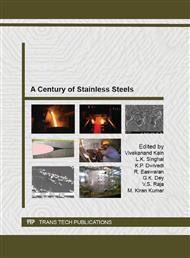p.564
p.575
p.583
p.592
p.598
p.606
p.618
p.626
p.632
Effect of Oxidation on Corrosion Behavior of Austenitic Stainless Steel 304L Welds
Abstract:
The in-cell stainless steel piping and erection works require extensive welding. In many instances the approach for gas tungsten arc welding (GTAW) is limited and it is not possible to provide a cover of high purity inert Argon gas (backing shield) and in some instances, oxidation of the weldment takes place. The oxide forms over the weld fusion zone (root pass) as well as a heat tint forms over the surfaces of the adjacent base material. In reprocessing and waste management plants, the welded pipes come in contact with the process fluid which is nitric acid of concentration up to 6 M and at temperatures up to boiling point. The present study was focused on preparing induced oxidized welds of type 304L using filler wire of type 308L, using gas tungsten arc welding (GTAW) process and studying their corrosion behavior in nitric acid environments. Sample welds were prepared under proper welding conditions and also with conditions in which deliberately Argon gas was not purged or partially purged. The weldments with no oxides, partial oxides and excess oxides on the weld root pass were used for corrosion and characterization studies. Micro Laser Raman spectroscopy established the oxide to be hematite. Metallographic examination of the cross-section of the weldment showed the thickness of oxide to be 200-300 mm. Corrosion tests of the weldments as per practice C, A262, ASTM were done for five periods. Metallographic examination was done after the practice C exposures and showed absence of oxides on the weld root pass. Type 304L specimens were heat treated at 500 – 900 °C for 5 minutes to generate heat tints. These specimens were tested as per practice C, A262, ASTM for 5h and four periods of 48 h each. The corrosion rate in the first five hours exposure was high for the specimen heat treated at 900 °C but it came down to normal values in subsequent exposures. To confirm the corrosion behavior of hematite and magnetite in boiling nitric acid, powders of pure Fe2O3 and Fe3O4 were tested in boiling 65% nitric acid. The results are analyzed to establish the behavior of oxides on the stainless steel welds in nitric acid.
Info:
Periodical:
Pages:
598-605
Citation:
Online since:
September 2013
Price:
Сopyright:
© 2013 Trans Tech Publications Ltd. All Rights Reserved
Share:
Citation:


